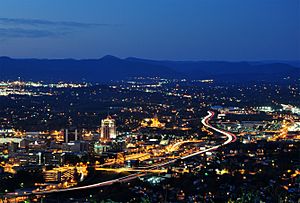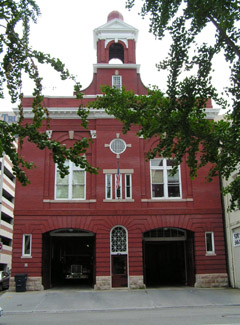Downtown Roanoke facts for kids
Quick facts for kids
Downtown
|
|
|---|---|

Downtown from the Mill Mountain Star overlook
|
|
| Country | United States |
| State | Virginia |
| City | Roanoke |
| Elevation | 925 ft (282 m) |
| Time zone | UTC-5 (EST) |
| • Summer (DST) | UTC-4 (EDT) |
| ZIP Codes |
24011
|
| Area code(s) | 540 |
Downtown is the busy heart of Roanoke, Virginia, in the United States. It grew a lot after the Shenandoah Valley Railroad arrived in 1882. Today, Downtown is the main center for business in the Roanoke Valley and Southwest Virginia. It's also home to fun places like the Roanoke City Market and many other cool spots.
Contents
Where is Downtown?
Downtown Roanoke is located in the middle of the city. The city describes it as the area bordered by Interstate 581 to the east and 5th Street to the west. To the north are the Norfolk and Western railroad tracks, and to the south is Day Avenue. This area is the main part of Downtown, including the historic Market District.
There's also another part of Downtown south of Day Avenue. It's bordered by the Roy L. Webber Expressway to the east and South Jefferson Street to the west. This area goes down to Albemarle Avenue. Here you can find the former Carilion Community Hospital and Jefferson College of Health Sciences.
Downtown Roanoke is surrounded by other neighborhoods. To the west is the West End, and to the east is Belmont. Gainsboro is to the north. To the south, you'll find Old Southwest and South Jefferson.
A Look Back: Downtown's History
Early Days and Railroad Growth
The first big European settlement nearby was Gainesborough, started in 1835. The very first buildings in what is now Downtown Roanoke, then called Big Lick, appeared after the Virginia and Tennessee Railroad arrived in 1852. Even though the railroad was damaged during the Civil War, it was fixed up later. One of the first public buildings in Downtown was a jail.
In 1881, the Shenandoah Valley Railroad announced that Big Lick would be the end of its line. This news caused the area to grow super fast! Big Lick officially became the city of Roanoke in 1882. In 1886, citizens voted to spend $90,000 on new roads and other important city structures. This helped the city expand quickly from the area around Campbell Avenue and Jefferson Street.
Growing Tall: Buildings and Changes
Between World War I and World War II, Downtown kept growing and doing well. Many new buildings were constructed. For example, the nine-story Boxley Building was built in 1921. The 11-story Patrick Henry Hotel followed in 1925. Then, the 12-story Colonial National Bank was completed in 1927. This bank building was the tallest in the city until the 1970s.
Downtown continued to be busy and successful into the 1950s. However, when Crossroads Mall opened in 1961, many shops in Downtown started to close. People began to shop outside the city center instead.
Even with fewer retail shops, the 1970s brought a lot of new construction. This changed the city's skyline. The 13-story Crestar Bank Building (now the BB&T Bank Building) and the 16-story First National Exchange Bank Building were finished in 1973. The 14-story Poff Federal Building was completed in 1976.
The Historic City Market
The Roanoke City Market started in 1882. It is the oldest farmers market in Virginia that has been open continuously. It's a central gathering place in Downtown. In the 1960s and 1970s, the market faced tough times. To help it, a plan called Design 79 was started to make the market area new and exciting again.
Modern Downtown
In the early 1990s, Downtown changed again with new tall buildings. The 21-story Dominion Tower (now the Wells Fargo Tower) was finished in 1991. It became the city's tallest building. The 12-story Norfolk Southern Building was completed the next year.
In the early 2000s, many old office buildings, stores, and warehouses in Downtown were turned into apartments and homes. This helped more people live right in the heart of the city.
Important Historic Places
Many buildings and areas in Downtown Roanoke are listed on the National Register of Historic Places. This means they are important to the history of the United States.
- Boxley Building
- Campbell Avenue Complex
- Colonial National Bank
- Fire Station No. 1
- First National Bank
- Patrick Henry Hotel
- Roanoke City Market Historic District
- Roanoke Downtown Historic District
- Roanoke Downtown Historic District (Boundary Increase)
- Roanoke Warehouse Historic District
- Salem Avenue-Roanoke Automotive Commercial Historic District
Other Cool Spots to Visit
- Taubman Museum of Art
- Center in the Square
- Virginia Museum of Transportation
- Wells Fargo Tower


